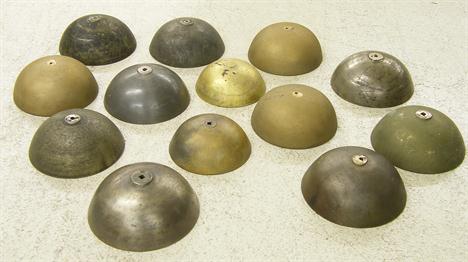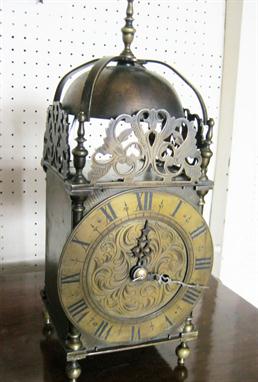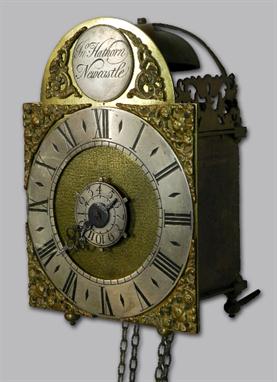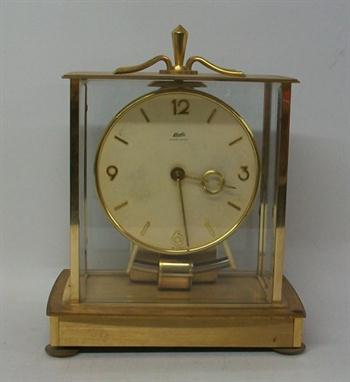We found 4372 price guide item(s) matching your search
There are 4372 lots that match your search criteria. Subscribe now to get instant access to the full price guide service.
Click here to subscribe- List
- Grid
-
4372 item(s)/page
james Webb, Bristol an early 18th century walnut longcase clock the eight-day duration, five pillar movement (fifth pillar missing) striking the hours on a bell with an outside countwheel, the eleven-inch square brass dial having a silvered chapter ring engraved with black Roman numerals, outer Arabic five-minute numerals, meeting-arrowhead half-hour markings and engraved either side of VI o’clock ‘J. Webb, Bristol’, with crown and cherub spandrels to the four corners, a matted centre with ringed winding holes, a subsidiary seconds dial and wheatear border engraving to the date aperture, with blued steel hands, the walnut case with crossbanding to the trunk door with a bulls-eye lenticle, book-matched veneers, panelled sides, a plain base and tapered three-quarter columns to the flat-top hood, with a c-scroll sound fret to the frieze, height 210cm. *James Webb was a member of the well-known Somerset clockmaking family and may well have been the maker recorded originally at Chipping Sodbury being the son of Edward of Chew Stoke where a lantern clock signed by him has been recorded. He is known to have married Martha Farmer on the 10th of October 1717 at St. Stephens Church, Bristol.
FRANKLIN MINT MINIATURE CLOCKS, 18, H 3" - 4": Including 1 "Gothic Steeple Clock"; 1 "Empire Carriage Clock"; 1 "Skeleton Clock" with glass dome; 1 "Cloisonné Clock"; 1 "Chinoiserie Bracket Clock"; 1 "Louis XV Lyre Clock"; 1 "Palladian Mantel Clock"; 1 "French Rococo Clock"; 1 "Colonial Grandfather Clock" [as is]; 1 "Louis XV Cartel Clock"; 1 "Federal Banjo Clock"; 1 "Federal Clock"; 1 "English Lantern Clock"; 1 "Victorian Mantel Clock"; 1 "Cuckoo Clock"; 1 "Acorn Shelf Clock"; 1 "Boudoir Clock" and 1 other unmarked Franklin Mint miniature clock with black lacquer style case and red rose decoration. All with box, most with paperwork.
A brass miniature striking lantern clock, signed 'J N Hathorn, Newcastle', the 4 3/4 inch arched brass dial with silvered chapter ring, central alarm ring and matted dial centre, the arch with circular silvered disc signed, the four posted movement with verge escapement and striking on a top mounted bell (at fault), 17.5cm high
A late 19th Century brass lantern clock with eight day movement striking on a gong, the floral engraved dial surrounded by a silvered chapter ring with black Roman numerals and inscribed `Tho. Watts, Hadleigh`, the case with typical bell surmount above pierced foliate panels and hinged sides, height approx 20.5cm, together with key.
A rare James I brass sundial. Inscribed John Robins, dated 1619. The 8.75 inch octagonal plate fitted with scroll decorated angled gnomen set at 51 degrees and centred with a thirty-two point compass rose with stylised sunburst and billowing cloud engraved decoration to segments and annotated NE, SE, SW and NE within the inner track, the middle track engraved N, E, S and W and inscribed Iohn Robins between N and E, the narrow outer track with Roman numeral chapters IIII-XII-VIII divided into quarter-hours as well as eighths, with floating asterisk half hour markers and engraved Anno Cristi *1619* between IIII and VIII, the angles with line engraved border panels and holes drilled for fixing. The engraved detail, octagonal shape and the profile of the original gnomen of the current lot closely conforms to features seen on three related sundials by William Bowyer, Richard Hinton and Isaac Symmes illustrated and discussed in White, George NOT A BAD TIMEKEEPER: THE ENGLISH LANTERN CLOCK IN THE SEVENTEENTH CENTURY (Antiquarian Horology Vol. 31 Sept. 2009 pages 624-8). Indeed the engraved N, E, S and W lettering is so close to those on the Hinton and Symmes dials that it would perhaps be reasonable to suggest that these three dials were engraved by the same hand. The narrow chapter ring, with its asterisk half-hour markers, also closely conforms with those of Bowyer and Hinton Dials and can be compared with the chapter rings applied to the earliest English domestic clocks such as Francis Nowe’s chamber clock of 1588 and the earliest ‘First Period’ lantern clocks made in the Harvey workshops (prior to 1620). The striking similarities between the current lot and the Hinton, Bowyer and Symmes dials is such that it is possible that they were all made for the same purpose in neighbouring workshops. As White suggests that these examples were made by clockmakers to be supplied alongside lantern clocks then it would perhaps be reasonable to suggest that the current lot was also possibly made by a clockmaker for the same purpose. If this is the case then a date of 1619 would place this dial amongst the products of a maker producing some of the earliest lantern clocks. The engraved name ‘Iohn Robins’ has clearly been added by a different hand than the maker of the dial -as indicated by style of the text with its hatched stems and very positioning on the dial. The style of the font (in particular the ‘s’ of ‘Robins’) suggests that this name was added soon after the dial was made and is probably more likely to be the name of the original owner rather than the maker. It is perhaps interesting to note that records indicate that a John Robins bought a farmhouse known as ‘Boddenhams’ from the Manor of Upton St. Leonards, near Gloucester in 1619. This location would certainly be close enough to the latitude 51 degrees North to allow the current lot to give reasonably accurate readings. Please note: The estimate in the printed catalogue is incorrect
A German Black Forest spring-driven wall clock with porcelain dial. Unsigned, mid 19th century. The outside countwheel gong striking movement with tic-tac escapement, silk suspension, lantern pinions and standing barrels for both the going and strike trains, the circular white enamel Roman numeral dial with steel moon hands and set into a shaped porcelain surround with gilt ivyleaf decorated crest and polychrome rose painted frieze panel flanked by relief flowerheads above conforming lion’s mask centred foliate decorated apron, the rear with dovetailed birch wood box incorporating sliding apertures to sides and pine rear cover fitted with a gong and with various repairer’s inscriptions dated 1899 and later, 32cm (12.5ins) high. The spring-driven movement in the current lot is unusual as most wall clocks made in the Black Forest at this time utilised weights for their motive power.
A George I thirty-hour posted longcase clock movement and dial. John Sanderson, Wigton, circa 1715. The two-handed countwheel bell striking movement with anchor escapement, the frame with column turned corner posts and ball feet, the 11.5 inch square brass dial with calendar aperture and ring turned ‘dummy winding hole’ decoration to the matted centre within applied Roman numeral chapter ring with complex cruciform half hour markers, Arabic five minutes to outer track and signed John Sanderson, WIGTON to lower edge, the angles without applied spandrels; with an oak wall bracket 46cm (18ins) high. John Sanderson is recorded in Loomes, Brian LANTERN CLOCKS & Their Makers as born in Wigton, Cumberland in 1671, he was orphaned at the age of twelve and brought up by his uncle. He was thought to have been apprenticed to John Ogden of Bowbridge and by 1691 he had set up business in Wigton and married a local Quaker girl, Elizabeth Pearson. John Sanderson was a colourful character who apparently travelled to as far afield as Edinburgh to attend Quaker meetings perhaps with the ulterior motive of using such gatherings to peddle his clocks. He had one son, also named John, who followed his father into the clockmaking trade but subsequently left to set up business in Newcastle-on-Tyne after a quarrel. John senior continued working in Wigton presumably until his death in 1754. The movement of the current lot is typical of Sanderson’s work as it closely resembles that of a lantern clock including turned posts and feet which were probably cast in his own workshop. The dial lacks the biblical motto for which Sanderson is famed, however is nicely detailed and distinctive in character. Such movements are thought to have originally been made to sit on wall brackets rather than be housed in a case; a well-made bracket is included in the lot in order for the clock to be enjoyed as the maker intended.
A Victorian brass lantern clock. Unsigned, mid to late 19th century. The five pillar twin chain fusee movement with anchor escapement and striking the hour on a bell mounted within the domed bell bearer above the frame, the brass dial with foliate engraved centre and silvered Roman numeral chapter ring with stylised wheatear half hour markers, the frame with ball feet, columnar uprights and urn finials flanking dolphin frets, with brass side doors and backplate, 39.5cm (15.5ins) high.
A brass quarter striking lantern clock. The dial signed for F. Coleman, Ipswich, mid 19th century incorporating early 18th century dial and frame. The five pillar twin chain fusee movement with anchor escapement and two-in-one ting-tang quarter striking on two bells mounted within the domed bell bearer above the frame, the brass dial with foliate engraved centre and Roman numeral chapter ring with stylised wheatear half hour markers and bearing the signature J. Coleman, Ipswich to lower edge, the frame with ball feet, columnar uprights and urn finials flanking dolphin frets, with brass side doors and backplate, 39.5cm (15.5ins) high.
A decorative brass ‘wing‘ lantern clock. Bearing signature William Speakman, 20th century incorporating earlier elements. The posted countwheel bell striking movement with verge escapement mounted above the top plate and pendulum with anchor-shaped bob set within the frame of the clock between the trains, the dial with alarm disc, foliate scroll engraved decoration and bearing signature William Speakman, Hatton garden fecit in a curve to the upper margin of the dial centre within applied silvered Roman numeral chapter ring and with pierced steel hand, the composite frame with ball feet, slender baluster turned columnar uprights and tall urn finials flanking early pattern scroll pierced frets beneath bell housed within the domed bearer above, with brass side doors applied with glazed extensions surmounted with pierced frets, the rear with iron backplate fitted with an alarm mechanism, hanging hoop and spurs, 39cm (15.5ins) high.
A Queen Anne brass lantern clock. Unsigned, early 18th century. The posted countwheel bell striking movement with verge escapement mounted above the top plate, the dial with rosette and foliate scroll engraved centre within applied silvered Roman numeral chapter ring with cruciform half hour markers with pierced steel hand and foliate decoration to angles, the frame with ball feet, columnar uprights and urn finials flanking dolphin frets beneath bell housed within the domed bearer above, with brass side doors, iron backplate, hanging hoop and spurs, 38cm (15ins) high.
A rare William III ebonised thirty-hour longcase clock. William Kenyon, Liverpool circa 1690-95. The four finned pillar countwheel bell striking two-handed movement with anchor escapement and 9.75inch square brass dial with circular calendar aperture to the symmetrical tulip decorated foliate engraved centre incorporating unusual ‘basket of bread’ motif to upper margin and with ring turned centre aperture, within applied silvered Roman numeral chapter ring with stylised sword hilt half hour markers, Arabic five minutes to outer track and signed W’m Kenyon, Leverpoole to lower edge, with pierced steel hands and applied winged cherub head and scroll cast spandrels to angles, the case with ogee cornice and swollen frieze above three-quarter pilasters to the glazed hood door above convex throat and slender trunk with rectangular door, on conforming plinth base with moulded skirt, 203cm (80ins) high. William Kenyon is recorded in Loomes, Brian LANCASHIRE CLOCKS and CLOCKMAKERS as believed born in 1667, Loomes further notes that various children, fathered by a William Kenyon, were born between the dates 1708-20. A James Kenyon is also recorded as working at Redcross Street in 1715 then Newmarket in 1725 and was declared insolvent in 1743. The delicate light symmetrical arrangement of engraved foliate scrolls with large tulip blooms issuing from a central element towards the lower margin of the dial centre of the current lot is very similar in style and feel to the engraving to the dial centre of a lantern clock by John Barton of Aughton/Ormskirk illustrated in Loomes, Brian LANTERN CLOCKS & Their Makers page 303. As Loomes suggests that the lantern clock by Barton dates to the 1690’s it would, on stylistic grounds, be reasonable to suggest that the current lot would date to the same decade. This date for the clock is perhaps further supported by the fact that Kenyon would have been of active working age at the start of the decade. As the cataloguer does not know of any other Liverpool-made clocks dating to before 1700 it would perhaps be reasonable to suggest that the current lot is possibly the earliest surviving clock to have been made in the city.
An extremely rare Charles II brass miniature lantern timepiece with original balance escapement and alarm. Unsigned, circa 1680. The posted movement with brass balance regulated crown wheel escapement and separate alarm mechanism fitted to the inside of the iron backplate sounding on a bell mounted within the domed bell bearer above, the frame with ball feet, column corner posts and vase turned finials, the dial with rosette decorated silvered alarm disc and original iron hand within engraved band of foliate tulip sprays incorporating monogram AM to upper margin, the applied silvered Roman numeral chapter ring with stylised wheatear half hour markers and quarter divisions to inner track, with dolphin pattern pierced frets, the rear with iron hoop and spurs for wall hanging (side doors lacking), 24.5cm (9.5ins) high. The current lot is extremely rare in that it still retains its original brass balance wheel escapement; although a small handful of full-size lantern clocks that retain their original balances are known, the cataloguer is not aware of another documented example of a miniature lantern clock surviving with its original balance wheel escapement intact. On close examination it can be seen that the dial engraving was originally laid out with the intention to leave a space for the signature of the maker within the upper margin of the centre, however, as it seems that the clock was to be supplied unsigned, the engraving was finished with the insertion of a flowerhead within this space. This inserted flowerhead incorporates the monogram AM (to the upper left lobe) which suggests the dial may have possibly been engraved by Abraham Martin who is recorded in Loomes, Brian The Early CLOCKMAKERS of Great Britain as an engraver from Geneva who was made a Free Brother of the Clockmakers’ Company in September 1682. Abraham Martin was a well-connected specialist workman who undertook work for Thomas Tompion (a watch dating to 1683 with case engraved by Martin resides at the Ashmolean Museum), he is also recorded receiving a gift of a month longcase clock from his friend, Richard Street, who was also known to have produced work for Tompion. It is perhaps interesting to further note that Tompion took in (through W. Dent) an apprentice named Jeremiah Martin in 1680. Fine quality movement details (notably the steel arbors incorporating delicate turned collets and the rare original steel wedges inserted into both the balance and alarm bottom potances) coupled with the fine engraving suggests that the current lot was made in the workshops of one of the leading London makers at this time; it is a shame that the decision was made to supply it unsigned. However the combination of these and other certain distinctive features, such as opposing steel and brass pulley cheeks and lugs riveted to the underside of the top plate for securing the movement bars, may assist to offer an attribution to a particular workshop with further research.
A fine Commonwealth period brass lantern clock. Henry Ireland, London, circa 1655. The posted countwheel bell-striking movement with balance regulated verge escapement and separately wound trains, the dial with fine iron hand with long arrowhead tail, and six-petal flowerhead to the bold floral trail engraved centre within applied narrow silvered Roman numeral chapter ring with stylised fleur-de-lys half hour markers and quarter-hour inner track, the angles with further foliate engraved infill, the standard London second period ‘Lothbury’ frame with column-turned posts beneath floral engraved and pierced front fret signed Henry Ireland at ye Dyall in Lothbury to lower edge, plain side frets and vase turned finials with domed bell bearer above, the sides with brass doors the rear with iron hanging hoop and backplate fitted with spurs, on ball feet, (escapement restored) 39cm (15.5ins) high. Henry Ireland is noted in White, George English Lantern Clocks page 134 as being apprenticed (alongside Thomas Knifton) to William Sellwood in 1632 for eight years, however it was not until 1654 that he was admitted to the Clockmakers’ Company as a free Brother (although it is generally accepted that he was producing clocks before that date). The reason for the substantial delay in his admission was probably down to the disruption experienced by the trade (and the operation of the Worshipful Company) caused by the unrest during the Civil War. The date of Henry Ireland’s death is not known however it is thought that he died between 1662 and 1671. Ireland chose to set up business in Lothbury, which by this time had become a hub for the horological trade mainly due to the abundant supply of brass and iron from nearby foundries. The efficient supply of raw castings lead to the emergence of a degree of standardisation with regards to frame patterns, with the current lot being classic example of the type used during the earlier part of the ‘second period’. The dial engraving again is typical of work produced in Lothbury by various makers during the 1650’s and can be closely compared to an example by Thomas Loomes illustrated in Loomes, Brian LANTERN CLOCKS & Their Makers on page 114, and another by Robert Robinson illustrated in the same publication on page 122. Please note: The height of the clock should read 30cm (12inches), excluding handle
RARE EARLY JAPANESE CLOCK - Japanese Lantern Clock or Kake-Dokei, Meiji Period, with iron top and bottom plates, engraved brass sides and face, brass bell, based on 18th c Dutch design, time and strike steel works with silk-suspended double arm crown escapement, fusee spring driven with alarm function, center steel disc rotates, carrying brass arm, outer ring indicates month, date indicated in upper right corner, hinged side panel, comes with fine lantern form wood and glass case on matching base, reticulated brass panels (one missing), clock is 5 1/2" (14.0 cm) tall, 3 1/8" (8.0 cm) square, case is 8" (20.3 cm) tall, 4 3/4" (12.1 cm) square, good as found condition, silk suspension missing.
A Dutch lantern clock Date of manufacture unknown, the dial painted ``Anno MDXXX`` (Year 1630), the tin and cast lead dial with polychrome painted scenic decoration, flanked by mermaids and with pierced figural crest, mounted on a wooden platform enclosing a verge and foliote escapement, 27`` H x 10.5`` W x 10.25`` D Provenance: Estate, Burbank, CA. Condition: Date unknown, as stated. General marks, scratches, rubbing and wear to surfaces overall. Rear wood panel a later replacement. The whole mounted on a new wooden base.Your bid indicates acceptance of our Conditions of Sale. AS-IS. ALL SALES FINAL
Small French Lantern Clock Unmarked, 8-day movement, brass case, enamel cartouche dial, height only 4 1/2 in., working, with wooden stand and glass dome. Kleine französische Laternenuhr Unbezeichnet, 8-Tage-Werk, Messinggehäuse, Zifferblatt mit Emaillekartuschen, Höhe nur 11,5 cm, funktioniert, mit Sockel und Glassturz. Condition: (2-3/-) Starting Price: €220
French Lantern Clock, 1772 Posted iron case, brass wheels, anchor escapement, 3 trains in a row, quarter-hour strike on 4 bells, cast-bronze front with sun, 25-piece enamel cartouche dial (hairline cracks), complete with pendulum and weights. Französische Laternenuhr, 1772 Geschmiedetes und offenes Eisengehäuse, Messingräder, Ankerhemmung, 3 Züge hintereinander angeordnet, 1/4-Stunden-Schlag auf 4 Glocken, gegossene Bronzefront mit Sonne, 25 Emaille-Kartuschen (mit Haarrissen), komplett mit Faltpendel und Gewichten. Condition: (3+/-) Starting Price: €750
French Lantern Clock, c. 1760 Marked: "Lesage à Perrier", 25-piece enamel cartouche dial on brass plate, cast brass crest, 8-day movement with special escapement, hour-strike on bell, alarm; with pendulum and weights. Französische Laternenuhr, um 1760 Bezeichnet: "Lesage à Perrier", emailliertes Mittelteil und 24 Kartuschen auf Messingplatte, Messinggußaufsatz, 8-Tage-Werk mit spezieller Hemmung, Stundenschlag auf Glocke, Wecker, mit Pendel und Gewichten. Condition: (2-3/-) Starting Price: €1200
-
4372 item(s)/page




















































